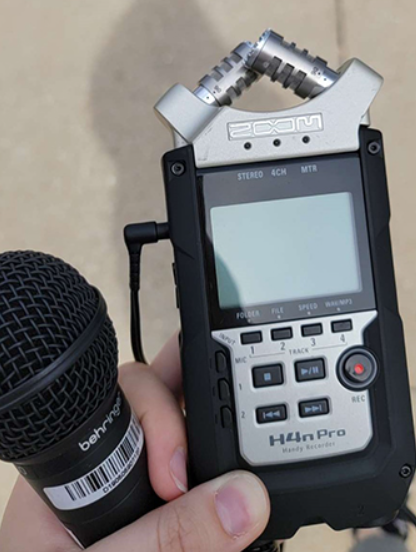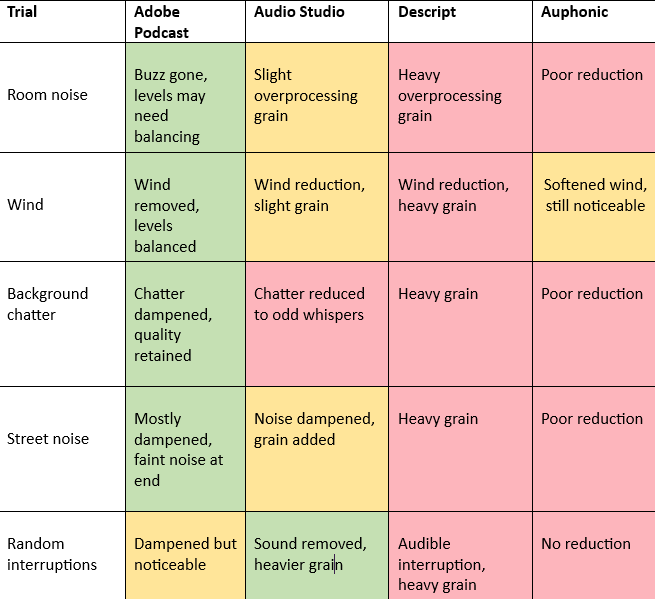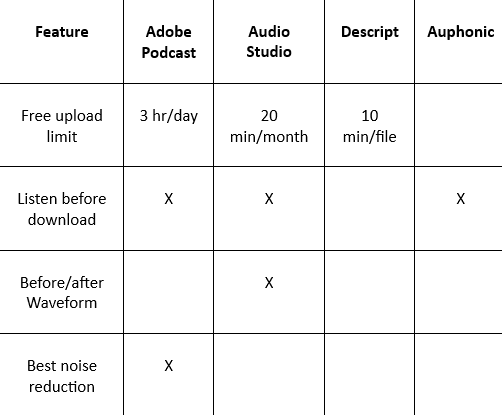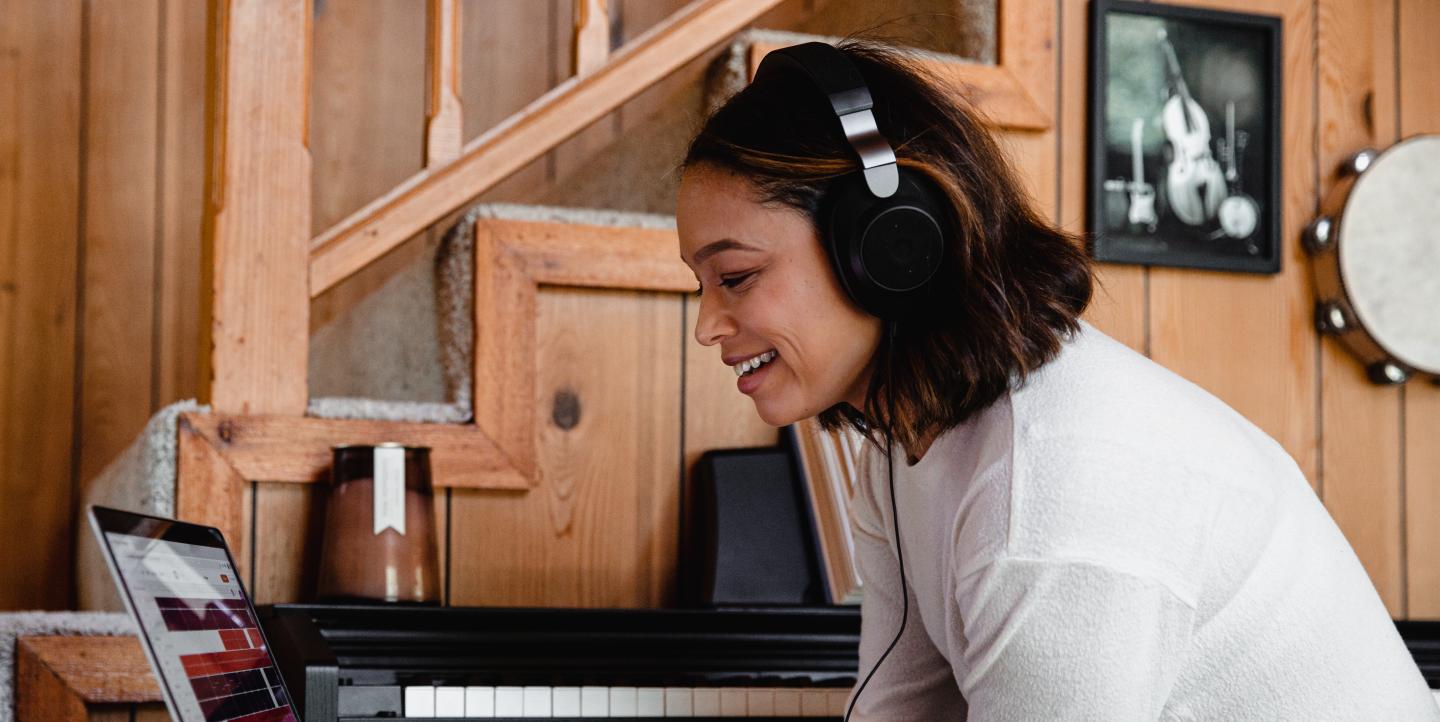Whether you’re an audio journalist, host a podcast or record audio interviews for stories on rare occasions — you’ve likely run into one (if not all) of the many common disruptions to clean audio: dogs barking, traffic blaring, winds howling, background buzzing from AC units, construction and more.
This month, Innovation in Focus tested four different AI audio editing services to see how they clean up imperfect audio for different situations.

We recorded audio with a Zoom and handheld that included:
- room noise
- wind
- background chatter
- street noise
- random interruptions
We edited all the audio gathered in Adobe Audition, then exported individual clips to the tools we tested: Adobe Podcast, Audo Studio, Descript and Auphonic.
Takeaways

If you’re looking for the most effective option with minimal processing residue, Adobe Podcast is your best bet. It also provides the most free uploads, with three hours of free enhancing available per day.
Audo Studio was the second most effective, but the audio still wasn’t 100% clean after the enhancement.
Both Descript and Auphonic could use some improvement, but if you’re interested, try running your own audio through some (or all) of these services to see if they match your needs.
Here are the specifics for each type of audio issue
Room noise
While the buzzing in the room wasn’t too noticeable, getting the audio closer to studio quality can help listeners focus more on the content – not the annoying buzzing sound in the background.
The best service for reducing room noise was Adobe Podcast. It made my voice much louder than the rest of the clip in an effort to overpower the room noise, but the enhancement also reduced the room noise. You may need to do some additional edits on an application like Audition to balance out the volume levels.
The volume of my voice was preserved with Audo Studio, but near the end of that portion, it began to sound a smidge over processed. Further down on the overprocessing spectrum, there’s Descript, which made my voice electronic and grainy, it was the audio equivalent of pixelation.
Auphonic sounded normal, but the noise reduction feature didn’t work well at actually reducing the background noise, you could still hear a few voices in the background.
Wind
Adobe Podcast fared the best with wind noise. The volume of my voice was balanced and the wind simply went away.
Audo Studio was similar, but still retained some grain (a fuzziness that makes the audio hard to understand). Descript did a great job of eliminating the wind, but still resulted in an electronic-sounding voice track. Finally, Auphonic softened the wind sound slightly, but it was still noticeable.
Background chatter
Chatter can often be a barrier to an engaged listener, but if you can’t get to a quiet place, Adobe Podcast can help. Adobe Podcast did a phenomenal job of removing the chatter from the background while retaining the authenticity of the voice track.
Audo Studio dampened the chatter (made it less audible and harder to hear), but the result left a strange whispering in the background. Descript had the same electronic voice problem as before, and Auphonic once again failed to substantially lessen the background noise.
Street noise
Street noise is the epitome of distraction: constant random sounds like construction, cars whizzing by, people talking, horns honking — all with almost no predictability. Adobe Podcast greatly dampened the background noise, with only a faint bit of construction noise audible near the end.
Again, Audo Studio also dampened the noise, but as with the other tests, the same grain was added to the clip. That grain, however, doesn’t come close to Descript, which once again automated my voice in an unnatural way.
And typical to the other tests with Auphonic, the background noise remained in the clip even after processing.
Interruptions
Finally, there’s the loud and unpredictable: you’re recording audio in what you think is a quiet environment, but an unexpected noise (like a door shutting) interrupts your or your source’s voice.
This test was the most telling of the power of some of these tools: Audo Studio’s ability to completely remove the door slam in the middle of my sentence was truly incredible. Still, the technology isn’t all there yet. Even with Audo Studio’s identification and muting of the interruption, I was left with an over-processed sound — even more so than other Audo Studio clips.
As for the other services, Adobe Podcast slightly dampened the sound of the door, but it was still noticeable. Descript maintained its track record of grainy processing, and the door slam was still audible. Lastly, Auphonic didn’t change much at all: my voice sounded normal, and so did the door slam drowning it out.
Additional features
In addition to the strength of the filters for editing, there are additional features that can add to what tool you use for specific needs. Here are some additional features each platform or tool provides to help you find a platform that works best for you.

This experiment used a Zoom recorder and a handheld microphone. If your publication is just starting in audio, these tools might not be accessible to you right away. Audio recorded with a phone or earbuds will likely not focus on a voice as well as the Zoom recorder, increasing your background noise and interrupts. Ultimately, use what you’ve got — and maybe an AI audio enhancer could help you out along the way.
This article was originally published at the Reynolds Journalism Institute at the University of Missouri.

